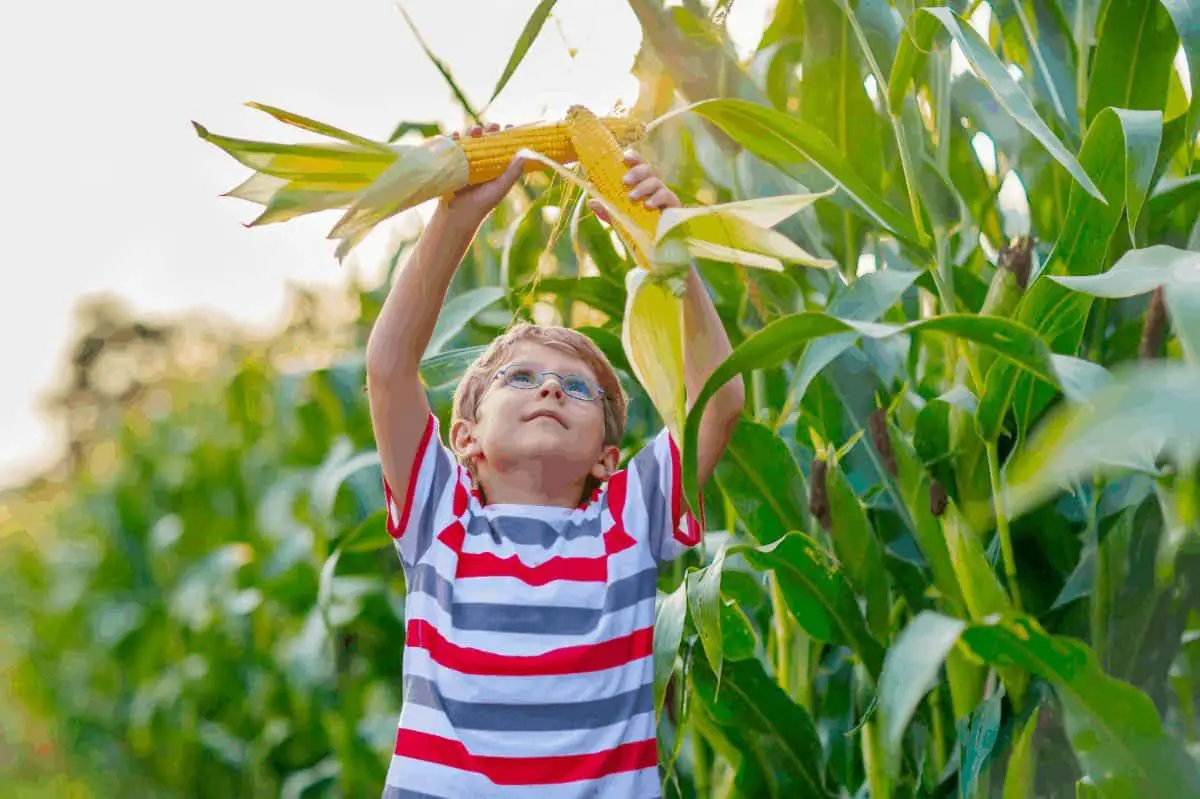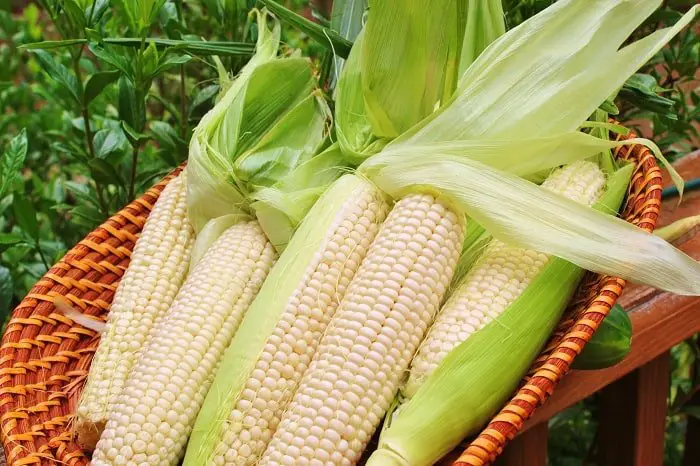Last Updated on December 30, 2021 by
Corns are sweet and that’s why we use them (sweet corns) to spice up meals, rice comes to mind. But there is a reason why you can call them delicious corns and that is hinged upon the right timing for harvesting. When you harvest them on time when they are matured and you get to enjoy all of the edible goodness they provide to your taste buds. Understanding the timings which answer the question “how to tell when corn is ready for picking” is key to everything down the path to harvesting corn you can enjoy. This is because, if you harvest them too early when they are yet to attain full sweetness, you can’t enjoy them that way, you won’t want to find out how unpleasant they can be at that level and if you delay in harvesting after they’ve attained the maturity stage and have also attained the full sweetness level, their kernels might have grown too rigid and starchy. This brings the need to understand and tell when your corn is ready for picking an inevitable one.
Continue reading to find out.
How to Know When your Corn is Ready for Picking
As you are now aware that their sweetness depends on you harvesting them at the right time, you should also note that the ears of the corn are ready for picking 20 days after you notice the appearance of the first silks. They should appear dry and brownish but the husks would retain their luxurious green color. To be certain if things are pretty okay on the inside, by okay I mean ripe for harvest, peel off the husk gently to reveal the white kernels resting undercover. Peel back the husk just enough to reveal the top of the ear. Then poke the kernel a little with a fingernail. If you notice a white liquid emerging out of the kernel, then it is ready for picking.
If however, the liquid is clear of any whitish or milky color, then the ear is yet to assume the ripened state in all of its fullness. Let it be and wait a little while. If the liquid substance coming out is very thick, it’s an indicator that it must have exceeded its ripened state while waiting for you. Also, the kernel should occupy the ear, if you still struggle to find the kernels after you’ve peeled off the husk in the ears, it could be that the said corn is yet to fully ripen. A fully ripened corn will fill out the ears. However, if other indicators say it’s a green and the ear is yet to be filled, you can still go ahead and harvest. Some varieties may have special qualities that might make them defy some growth patterns. You are also free to taste the raw kernels. If they are fully ripened, they will taste very sweet and firm on the mouth.
Opening the husk can be a risky play. If the kernels are yet to mature and you expose them to the outside environment, you make them vulnerable to attack from insects and birds who prey on them as they ripen. So it’s best advised not to open the husk. You can avoid peeling off the husks by becoming a better observer of the ears. You can feel the ears and tell if they are ready for picking. If the ears of the corn are rounded and blunt instead of pointed, then it is ready.
How to Pick Corn the Right Way
When harvesting, grab the ear and pull it down. Since it is ready for harvest, you won’t have to sweat the process out. When the ear is down, you can pull and twist to bring corn out of its stalk. When harvesting, hold the corn stalk as you pull and twist. This is to ensure you don’t damage the plant that is hosting other ears. When you are done harvesting, pull up the corn stalks instantly, cut them into a foot lengths then add them back to the soil so they can decay. Corn stalks are most times difficult to compost, you can just burn them off or throw them away.
Other Things to Note
If you are harvesting, then be certain you are going to be consuming instantly. Corns are best eaten after harvest since their sugars are yet to be converted to starch. When you store them, the sugars get converted to starch and too much starch might not be healthy for you. Their sweetness also depends on how quick you consume them after harvesting. Most persons keep their water boiling before going to harvest so they waste no time in processing them for consumption. This is the reason why freshly harvested corn tastes better than the one you got from the grocery store.
If you still want to store them, you can store the ears of the corn in the refrigerator without removing their husk. You can preserve them for about a week this way. If you want to keep them longer this period, then you need to blanch the ears in boiling water for about 2 minutes and freeze in closely tight bag that gives no room for the passage of air. This is to ensure they maintain optimal freshness.
Conclusion
Harvesting is an important time and process in the cycle of eating delicious fruits from your garden. It’s as important as the planting time and process. But more importantly, if you harvest at the wrong time, you end up with the wrong fruit or produce. All the time spent in attending to the plant from cradle to maturity is wasted. All your efforts will have dissipated into thin air by then and you end up fruitless. Corn is a sweet garden produce and the best way to enjoy it is if you know how to tell when corn is ready for picking. This has been addressed here and it’s your duty to follow them and get the best out of your corn.
FAQs
What happens if you pick corn too early?
When crops are harvested prematurely, they have a higher chance of becoming diseased and unusable. This is because immature plants still have green leaves that can be easily infected by insects and diseases.
If the corn in the field doesn’t ripen, it's best to leave it alone for another few weeks. It will likely get ripe on its own before you need to harvest it and avoid any potential loss of yield or quality.
How can you tell if sweet corn is ripe?
The most common way to determine if the sweet corn is ripe is to feel for the popping kernels. When the corn kernels pop and break, it signals that it is time to harvest.
There are several other factors that you can use to identify sweet corn:
1) The ears of the corn will begin turning yellow near their tips as soon as they reach a certain size. While plant leaves are still green, they do not have enough chlorophyll content which means that they will not be able to trap solar energy efficiently. This makes plants vulnerable for pests and disease which in turn decreases their ability to store carbohydrates for later use. Corn may also become bitter when it has reached its peak ripeness.
2) The kernels on the ears of corn should feel firm but not hard or tough when pressed.
How long can you leave corn on the stalk?
The average corn on the stalk can be left on the stalk for 3-5 days. But if you leave it longer, you will see some of it getting blown off. This is due to the fact that weather conditions cause the corn to dry out and fall off.
What month is corn harvested?
The month of corn harvest can vary depending on regions and local climates. In some places in the southern United States, corn is harvested from November to February, while in other areas, it’s harvested from April to June.
Why is my corn so small?
In many years, scientists have not been able to figure out why the corn crops of the US are way smaller than the cobs they used to grow in the past.
Corn farmers are still struggling with this dilemma, but some scientists have come up with a new theory that might give them a glimmer of hope.
Some scientists theorize that there is a connection between modern agricultural practices and shrinking cobs. They believe that corn is smaller because we use fertilizers and pesticides in order to increase crop yield. The fertilizer and pesticides also kill off beneficial insects that help corn grow tall and strong.
Does corn grow back every year?
Most people are familiar with the fact that corn grows back every year. Whether it's a field of corn, or a crop harvested from the field, this cycle of growth and death continues over time.
Does corn grow back every year? Well, no, but it does not grow back every year. Planting new seeds after harvesting the old crop allows for continuous production of plants to follow the cycle.
Can you plant corn in the same place every year?
The answer to this question is yes, as long as you are not trying to grow corn on a consistent basis. If you plant corn in the same area every year, it may die because the soil can become depleted of nutrients.
Crop rotation is the practice of growing different crops in different areas of land each year. It is designed to keep the soil from running out of much-needed nutrients and builds up organic matter. Crop rotation can also help prevent pest infestations and weeds.
It eliminates issues such as shade problems, wind damage, and erosion from one crop's effects on another crop's growth cycle.
amzn_assoc_placement = “adunit0”;
amzn_assoc_tracking_id = “gardeningdreams-20”;
amzn_assoc_ad_mode = “manual”;
amzn_assoc_ad_type = “smart”;
amzn_assoc_marketplace = “amazon”;
amzn_assoc_region = “US”;
amzn_assoc_linkid = “3e87b41251521bf650b4c1fd41723c3d”;
amzn_assoc_design = “in_content”;
amzn_assoc_asins = “B002VTDMYE,B000PDY3HI”;
Tony Manhart is a passionate gardener who has been tending to gardens for over 20 years. He takes pride in creating beautiful outdoor spaces with plants, trees, and shrubs that can thrive in any environment. He loves to share his knowledge with others and has taught classes on gardening basics and advanced techniques. He is committed to sustainability, using natural and organic methods to create and maintain gardens. He also works with local organizations to create green spaces for communities. When he’s not gardening, Tony enjoys hiking, reading, and spending time with his family.




